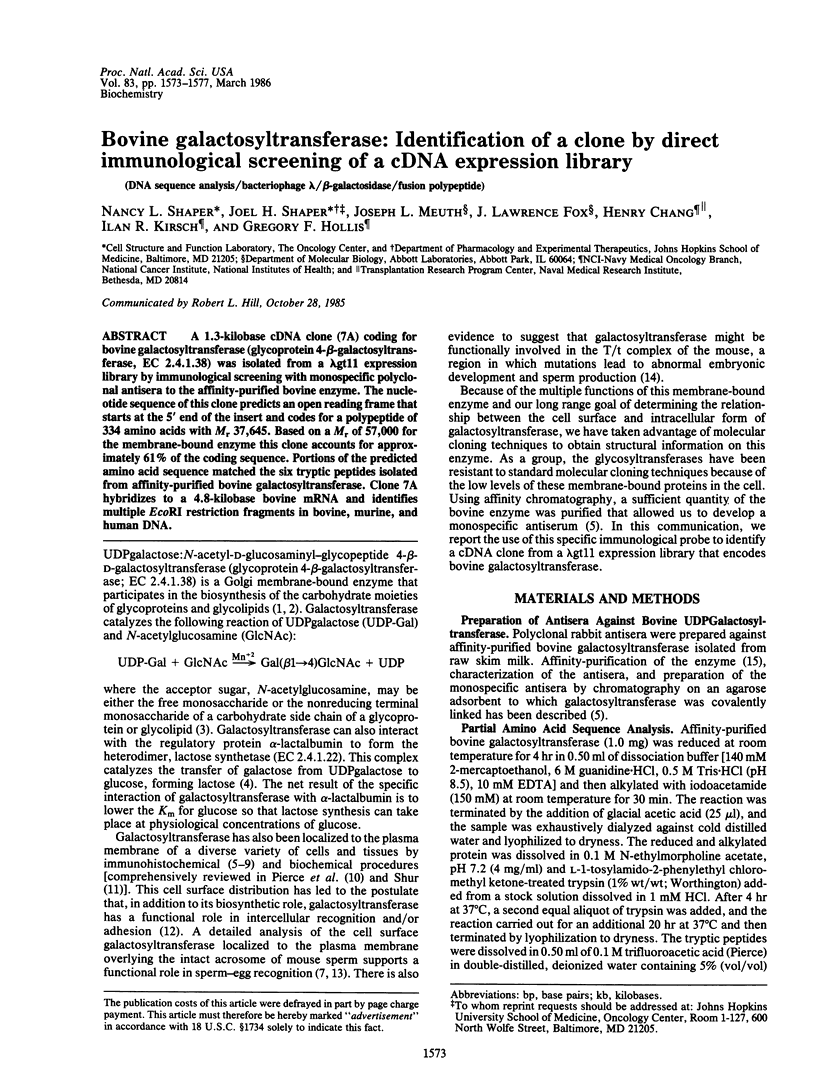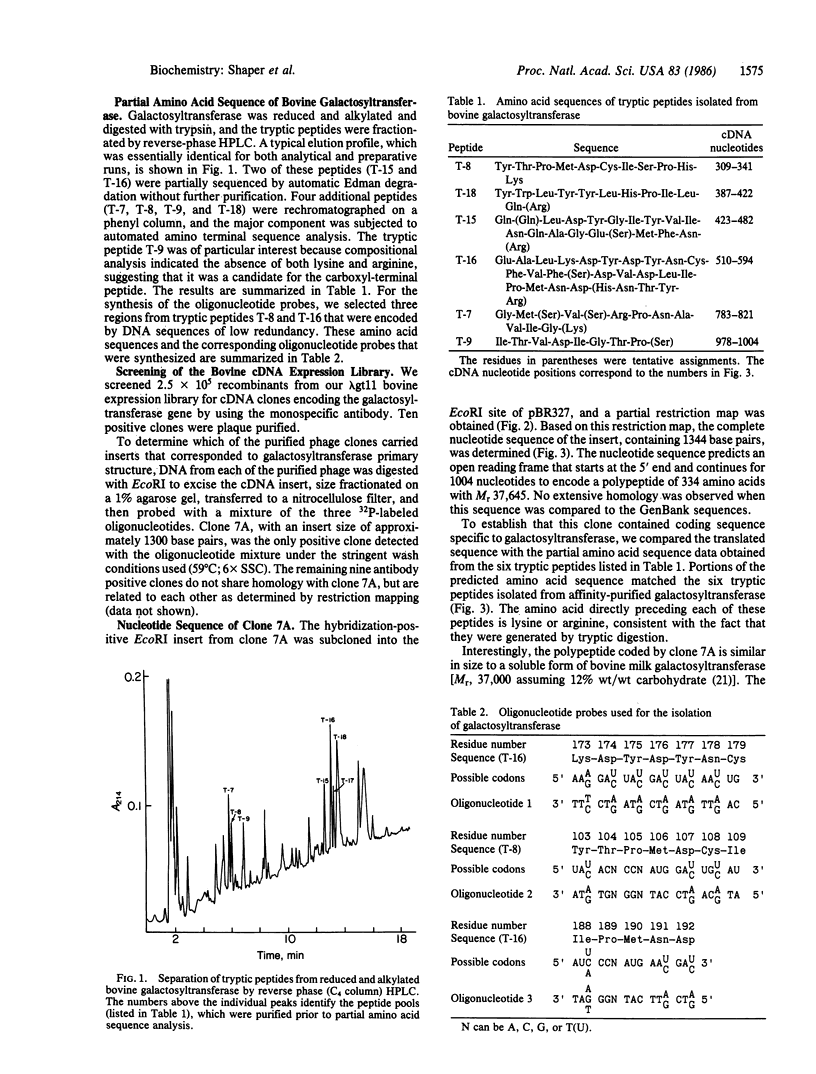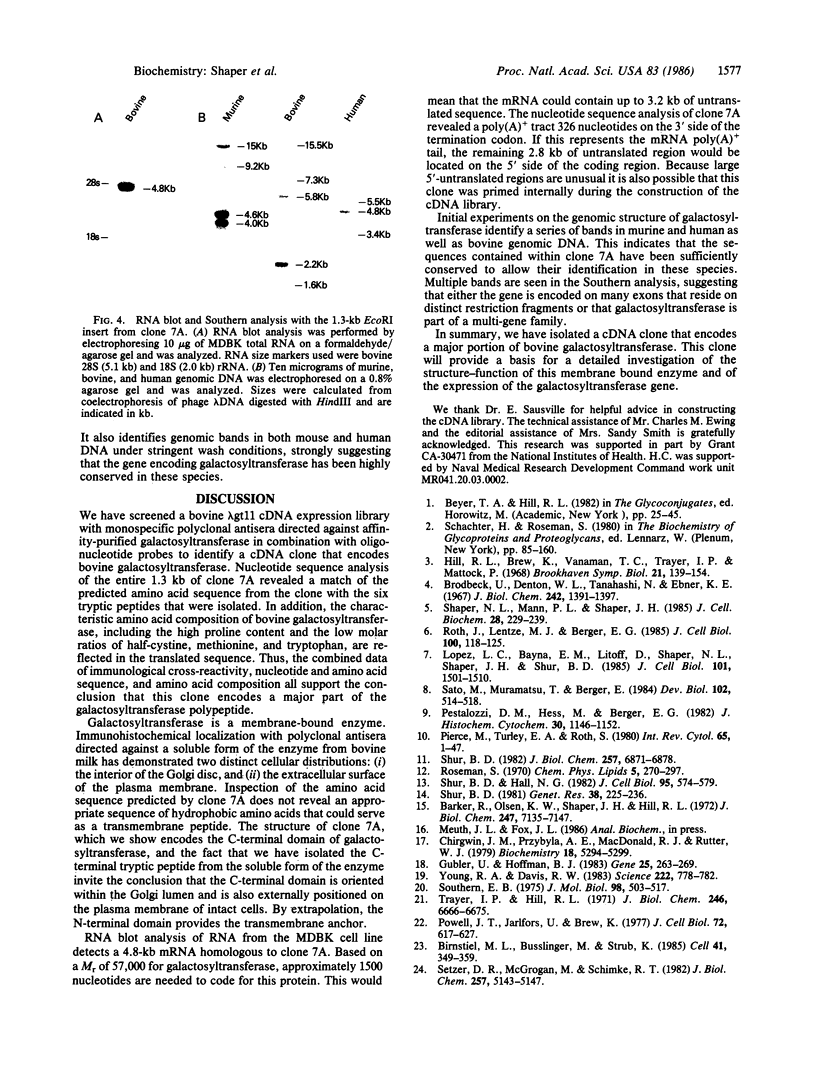Abstract
A 1.3-kilobase cDNA clone (7A) coding for bovine galactosyltransferase (glycoprotein 4-beta-galactosyltransferase, EC 2.4.1.38) was isolated from a lambda gt11 expression library by immunological screening with monospecific polyclonal antisera to the affinity-purified bovine enzyme. The nucleotide sequence of this clone predicts an open reading frame that starts at the 5' end of the insert and codes for a polypeptide of 334 amino acids with Mr 37,645. Based on a Mr of 57,000 for the membrane-bound enzyme this clone accounts for approximately 61% of the coding sequence. Portions of the predicted amino acid sequence matched the six tryptic peptides isolated from affinity-purified bovine galactosyltransferase. Clone 7A hybridizes to a 4.8-kilobase bovine mRNA and identifies multiple EcoRI restriction fragments in bovine, murine, and human DNA.
Full text
PDF




Images in this article
Selected References
These references are in PubMed. This may not be the complete list of references from this article.
- Barker R., Olsen K. W., Shaper J. H., Hill R. L. Agarose derivatives of uridine diphosphate and N-acetylglucosamine for the purification of a galactosyltransferase. J Biol Chem. 1972 Nov 25;247(22):7135–7147. [PubMed] [Google Scholar]
- Birnstiel M. L., Busslinger M., Strub K. Transcription termination and 3' processing: the end is in site! Cell. 1985 Jun;41(2):349–359. doi: 10.1016/s0092-8674(85)80007-6. [DOI] [PubMed] [Google Scholar]
- Brodbeck U., Denton W. L., Tanahashi N., Ebner K. E. The isolation and identification of the B protein of lactose synthetase as alpha-lactalbumin. J Biol Chem. 1967 Apr 10;242(7):1391–1397. [PubMed] [Google Scholar]
- Chirgwin J. M., Przybyla A. E., MacDonald R. J., Rutter W. J. Isolation of biologically active ribonucleic acid from sources enriched in ribonuclease. Biochemistry. 1979 Nov 27;18(24):5294–5299. doi: 10.1021/bi00591a005. [DOI] [PubMed] [Google Scholar]
- Gubler U., Hoffman B. J. A simple and very efficient method for generating cDNA libraries. Gene. 1983 Nov;25(2-3):263–269. doi: 10.1016/0378-1119(83)90230-5. [DOI] [PubMed] [Google Scholar]
- Hill R. L., Brew K., Vanaman T. C., Trayer I. P., Mattock P. The structure, function, and evolution of alpha-lactalbumin. Brookhaven Symp Biol. 1968 Jun;21(1):139–154. [PubMed] [Google Scholar]
- Lopez L. C., Bayna E. M., Litoff D., Shaper N. L., Shaper J. H., Shur B. D. Receptor function of mouse sperm surface galactosyltransferase during fertilization. J Cell Biol. 1985 Oct;101(4):1501–1510. doi: 10.1083/jcb.101.4.1501. [DOI] [PMC free article] [PubMed] [Google Scholar]
- Pestalozzi D. M., Hess M., Berger E. G. Immunohistochemical evidence for cell surface and Golgi localization of galactosyltransferase in human stomach, jejunum, liver and pancreas. J Histochem Cytochem. 1982 Nov;30(11):1146–1152. doi: 10.1177/30.11.6815262. [DOI] [PubMed] [Google Scholar]
- Pierce M., Turley E. A., Roth S. Cell surface glycosyltransferase activities. Int Rev Cytol. 1980;65:1–47. doi: 10.1016/s0074-7696(08)61958-0. [DOI] [PubMed] [Google Scholar]
- Powell J. T., Järlfors U., Brew K. Enzymic characteristics of fat globule membranes from bovine colostrum and bovine milk. J Cell Biol. 1977 Mar;72(3):617–627. doi: 10.1083/jcb.72.3.617. [DOI] [PMC free article] [PubMed] [Google Scholar]
- Roseman S. The synthesis of complex carbohydrates by multiglycosyltransferase systems and their potential function in intercellular adhesion. Chem Phys Lipids. 1970 Oct;5(1):270–297. doi: 10.1016/0009-3084(70)90024-1. [DOI] [PubMed] [Google Scholar]
- Roth J., Lentze M. J., Berger E. G. Immunocytochemical demonstration of ecto-galactosyltransferase in absorptive intestinal cells. J Cell Biol. 1985 Jan;100(1):118–125. doi: 10.1083/jcb.100.1.118. [DOI] [PMC free article] [PubMed] [Google Scholar]
- Sato M., Muramatsu T., Berger E. G. Immunological detection of cell surface galactosyltransferase in preimplantation mouse embryos. Dev Biol. 1984 Apr;102(2):514–518. doi: 10.1016/0012-1606(84)90219-7. [DOI] [PubMed] [Google Scholar]
- Setzer D. R., McGrogan M., Schimke R. T. Nucleotide sequence surrounding multiple polyadenylation sites in the mouse dihydrofolate reductase gene. J Biol Chem. 1982 May 10;257(9):5143–5147. [PubMed] [Google Scholar]
- Shaper N. L., Mann P. L., Shaper J. H. Cell surface galactosyltransferase: immunochemical localization. J Cell Biochem. 1985;28(3):229–239. doi: 10.1002/jcb.240280305. [DOI] [PubMed] [Google Scholar]
- Shur B. D. Evidence that galactosyltransferase is a surface receptor for poly(N)-acetyllactosamine glycoconjugates on embryonal carcinoma cells. J Biol Chem. 1982 Jun 25;257(12):6871–6878. [PubMed] [Google Scholar]
- Shur B. D. Galactosyltransferase activities on mouse sperm bearing multiple tlethal and tviable haplotypes of the T/t-complex. Genet Res. 1981 Dec;38(3):225–236. doi: 10.1017/s0016672300020577. [DOI] [PubMed] [Google Scholar]
- Shur B. D., Hall N. G. A role for mouse sperm surface galactosyltransferase in sperm binding to the egg zona pellucida. J Cell Biol. 1982 Nov;95(2 Pt 1):574–579. doi: 10.1083/jcb.95.2.574. [DOI] [PMC free article] [PubMed] [Google Scholar]
- Southern E. M. Detection of specific sequences among DNA fragments separated by gel electrophoresis. J Mol Biol. 1975 Nov 5;98(3):503–517. doi: 10.1016/s0022-2836(75)80083-0. [DOI] [PubMed] [Google Scholar]
- Trayer I. P., Hill R. L. The purification and properties of the A protein of lactose synthetase. J Biol Chem. 1971 Nov;246(21):6666–6675. [PubMed] [Google Scholar]
- Young R. A., Davis R. W. Yeast RNA polymerase II genes: isolation with antibody probes. Science. 1983 Nov 18;222(4625):778–782. doi: 10.1126/science.6356359. [DOI] [PubMed] [Google Scholar]






